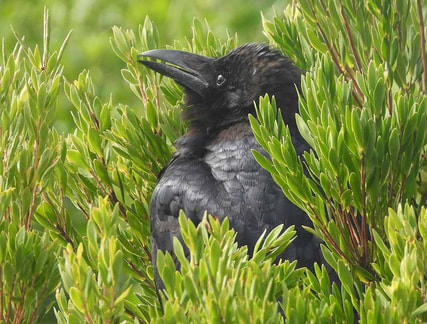 A mass gathering of ravens intrigues Ed Thexton. Photo: Steve Dunn
A mass gathering of ravens intrigues Ed Thexton. Photo: Steve Dunn SUMMER fruits are to die for. The cherry. The prince of fruits. The crispness, the colour and then there is the taste. It reveals the peach as little more than a trumped up, if delicately flavoured, bruise merchant; the mango as a tropical want-to-be and the store-bought apricot simply as a perennial disappointment, somewhere between rock and mush.
We humans are not the only ones who relish the summer fruits. Arguably, the smartest bird on the block, at least around here, reckons them not too bad a thing, or at least that is what their flocking to the coastal indigenous shrubbery would suggest.
Speaking of eyes, the photo is of a youngster. You can tell by the complete black eye. At about three years of age, I’m told, the mature bird will retain a black pupil and develop a slim iris surrounding it of light blue, which is, in turn, surrounded by a distinctive white or sclera.
Last week we drove the Inverloch to Cape Paterson Road for a snorkel timed to explore the abundance of life on the extensive intertidal sandstone rock platforms. We ended up at that truly beautiful beach, The Oaks. The Oaks is within the Bunurong Marine National Park (21 square kilometres, declared in 2002), which is in turn within the new Yallock-Bulluk Marine and Coastal Park which combines 40kms of coastal reserves from San Remo to Inverloch.
Relative to terrestrial Bass Coast Shire the marine area is the true repository of biodiversity. Along the way we could not fail to see the large numbers of ravens in the ridiculously reduced band of coastal shrubbery.
The ravens were in their multiple hundreds, thousands. This is a spectacle and clearly a significant event in the lives of the local ravens and those from kilometres around. A short-lived spectacle at that, because a week later even though fruit is still around there’s not a sign of a raven, just the call of the beautiful silvereye, much harder to see but not to hear, with their high-pitched peep. And I suspect, although not much around at midday, the starlings.
Closer examination reveals that the attraction is the coastal shrubs. Four species were positively laden with fruit upon which the ravens gorged. Colour coded fruit: Coastal Saltbush crimson, Sea Box red, Coastal Beard Heath white, and Common Boobialla purple.
Bird droppings reveal that for the plants this is a significant seed distribution event as well. The fruiting coastal shrubs now dominate the sea cliff vegetation between Inverloch and Cape Paterson. There are older people around who speak with affection of the near continuous views of the sea that could be had from the car “before that scrub came back”.
Those views were a result of stock grazing. Grazing to the very edge of these cliffs. The vegetation is regenerating, in places aided by the planting of the South Gippsland Conservation Society. Tree plantings that are now so large that you can barely believe they are planted, like those She Oaks at Shack Bay on either side of the stairs down the kamikaze slope.
We look at the significance of the fruiting shrubs to the hard-to-miss, if short lived, masses of ravens and reflect on the significance to more obscure species like the silvereye. The ravens, particularly when massed, are like a flagbearer for all the other more obscure species. The enfeebled state of the coastal vegetation becomes obvious when viewed with Google Earth or better still a drone video. It is not hard to deduce how this loss has reduced our wildlife.
The good news is that there is plenty we can do to support more wildlife. In our towns, Inverloch for example, the coastal vegetation is almost as sparse as the management funding. In places it is weeded heavily, in others almost non-existent. It is not an either-or choice between having bush or having views. All vegetation management is about choices. In a town setting it is obviously an accommodation of people and natural values. After all, it is public land.
Coastal vegetation management in towns is a rich topic of which more can be spoken of later. Now, back to a less contentious topic - murder and unkindness. For an illuminating and humorous exposition I direct you to ‘Back in Black’ Australian Ravens and Crows’, a video posted on YouTube by the Backyard Naturalist.
If you take nothing else from this meandering video, you will learn this critical distinction derived from old English in the dim dark past. When speaking of your crow and its gatherings, you refer to it as a murder of crows. When speaking of your raven and its gathering, on the other hand, you refer to it as an unkindness.